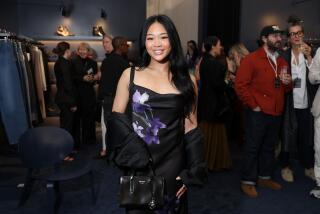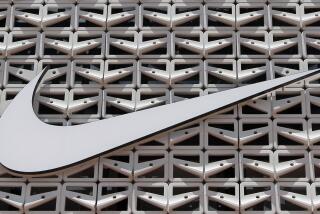An Unseamly Performance
Apparel designer Tommy Hilfiger unveiled his flagship store on Beverly Hills’ swank Rodeo Drive over the weekend amid the glittery hype that always accompanies the fashion scene, with movie stars and other celebrities helping cheer on the grand opening.
But if you bought Tommy’s stock (ticker TOM) a year ago and held it, you’re not smiling--you’re under water by a whopping 26%. Same story for those who bought shares of designer Donna Karan’s (DK) company.
How about those who bought shares of Polo Ralph Lauren Corp. (RL) when that company had its red-hot initial public offering in June, at $26 a share? They’re not beaming, either, because they’ve suffered a 13% loss if they still hold the stock.
The list goes on and on. The stock of Quiksilver Inc. (QUIK), a Costa Mesa-based maker of casual sportswear, was hammered last week amid concerns that its earnings growth is slowing. Mossimo Inc. (MGX), an Irvine-based sportswear maker that’s in deep trouble, saw its stock sink to a 52-week low.
And as the accompanying chart shows, just about every stock involved in fashionable brand-name apparel and accessories--especially those of companies catering to high-end shoppers with plenty of disposable cash--has left investors in tatters during the last year.
And it’s not that the stocks aren’t keeping up with the market; they’re not going up at all.
What’s happening here?
To be sure, there are unique problems at each company. Donna Karan International Inc., for instance, has been wracked with bloated costs, internal turmoil and eroding profit. Talbots Inc. (TLB) made a disastrous move away from its classic conservative wear, reversed course and is now struggling to get back on track.
Or consider Gucci Group (GUC), the famed maker of luxury accessories. Despite a remarkable comeback from severe problems in the early 1990s--sales and profit have more than doubled in the last two years--Gucci’s stock has plunged 56% over the last 12 months.
That’s because, on Sept. 24, Gucci warned of lower-than-expected profit in the latter half of 1997, mainly because the strong dollar and weak Japanese yen were slowing tourism sales and its overseas results. The stock plummeted more than $11 a share that day alone, to $47.33. But sellers were just getting warmed up; the stock now trades at $33.
Even the economic woes in Asia--where clothing companies make so many of their goods--aren’t much help for now. Yes, currency devaluations there are shaving U.S. companies’ production costs in the region, but those factories are making clothes for sale nine months from now, so the real savings won’t be felt for some time.
But whether it’s foreign-exchange turmoil, unpopular styles, poor management or a fashion house’s inability to grow beyond its niche of selling to well-heeled buyers, it all adds up to a lousy rag trade in the view of investors.
“People are simply disenchanted” with the industry’s uneven results, especially against the backdrop of always-fickle fashion tastes and lackluster apparel spending generally, said Jennifer Black Groves, whose Black & Co. investment firm in Portland, Ore., specializes in apparel stocks.
After all the hype surrounding these stocks and their headline-grabbing designers dies down, the number of companies with good growth prospects, strong balance sheets and savvy managements “makes for a thin list,” she said.
Not on the list is Donna Karan International. Though many of her designs still get raves from critics, her company’s performance has repeatedly come up short, and the stock now sells for half the $24 a share it fetched at its original public offering in June 1996.
The latest blow came last week, when Donna Karan said its third-quarter profit plunged 90% and that it planned to slash 15% of its work force and take $64 million in pretax charges to further repair its operations. That will result in a pretax loss of about $80 million for the fourth quarter.
But even amid this carnage, there are still a few fashion stocks that analysts are urging investors to try on for size.
One is Tommy Hilfiger (pronounced HILL-figger). Josephine Esquivel of Morgan Stanley, Dean Witter, Discover & Co. recently reiterated her “strong buy” on the stock after the maker and seller of men’s, women’s and children’s apparel posted a 32% jump in profit for its fiscal second quarter ended Sept. 30.
She also pushed up her estimate of Hilfiger’s full fiscal-year earnings per share by a few cents, and set a target price of $60 for the stock. But several other analysts are more cautious.
Allison Malkin, analyst at SBC Warburg Dillon Read, said, “The reason the stock has been so weak is because Hilfiger’s inventories have grown at a higher rate than its sales.” That means Hilfiger might have to cut prices to pare its unsold stockpile, “and that could hurt its profit margins,” she said.
Malkin is more bullish on Polo Ralph Lauren, currently at $27.50 a share. The company’s sales--particularly of men’s sportswear--are “doing extremely well,” its inventories aren’t excessive and its licensing business is very strong, she said.
Earlier this month, Polo Ralph Lauren posted a 37% surge in profit for its fiscal second quarter ended Sept. 27 on a 20% gain in revenue.
Indeed, sales of Ralph Lauren clothing for which Jones Apparel Group (JNY) holds licenses to market is a key reason why Jones is among the few fashion stocks that’s riding high--just as it has for the last three years.
Jones, whose brands include Jones New York and Evan Picone, also gets kudos for consistently popular styles, strong management and timely deliveries. That’s why, despite surging 43% over the last 12 months, Jones is among the apparel stocks most recommended by analysts, including Groves, Malkin and Carol Pope Murray of J.P. Morgan Securities Inc.
Jones, along with Liz Claiborne Inc. (LIZ), is such a proven winner in department stores that the stores keep giving the line sizable square footage, and that helps the company maintain its growth rate, analysts said.
But Claiborne learned that such space has to be earned. A favorite choice for women’s career wear in the 1980s, Claiborne lost its touch in the early 1990s but has since bounced back with popular designs and better management. Several analysts rate it a “buy.”
How, then, to explain the stock of Irvine-based St. John Knits Inc. (SJK)? Its collection of higher-priced women’s apparel has been a strong seller for years, and its stock quintupled in price from 1993 through ’96. Yet the stock has tumbled 28% from its peak of $54.50 last June, even though it remains among the analysts’ favorites.
“Consumers crave their products,” and St. John’s “gross [profit] margins are higher than anyone in the industry, and we’re recommending it,” said Groves. Her only explanation for why the shares are down: investors’ general dislike of apparel stocks.
(BEGIN TEXT OF INFOBOX / INFOGRAPHIC)
Out of Fashion
Investors have been turned off by most apparel and accessories stocks, in good part because the companies’ growth rates keep disappointing Wall Street. Here are some of the players:
*--*
Ticker Monday % Change Stock symbol close last 12 months Gap GPS $54.75 +80% Jones Apparel JNY 46.50 +43 Quiksilver QUIK 25.38 +22 Liz Claiborne LIZ 51.19 +20 Nautica Enterprises NAUT 27.50 -13 Polo Ralph Lauren RL 27.50 -13* St. John Knits SJK 39.13 -15 Talbots TLB 22.94 -14 Donna Karan Intl DK 12.44 -18 Guess GES 8.88 -25 Tommy Hilfiger TOM 40.00 -26 Ann Taylor Stores ANN 13.94 -30 Oakley OO 9.00 -40 Donnkenny DNKY 3.38 -52 Gucci GUC 33.00 -56 Mossimo MGX 5.31 -65 S&P; 500 +28%
*--*
*Since initial public offering June 12
Source: Bloomberg News
*
Times staff writer James F. Peltz can be reached at james.peltz@latimes.com







